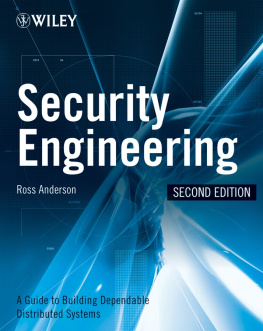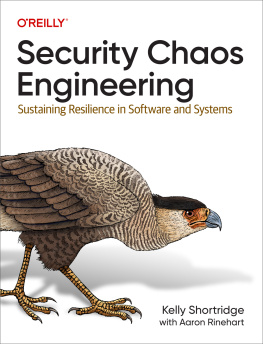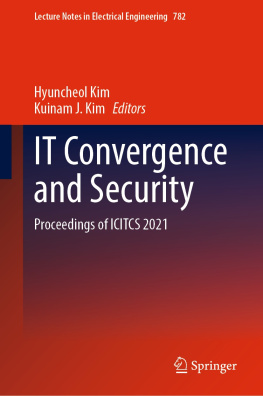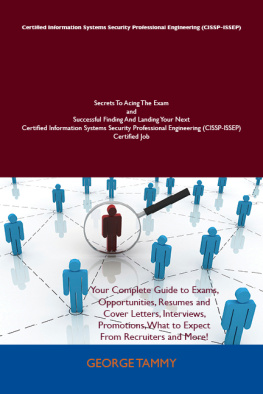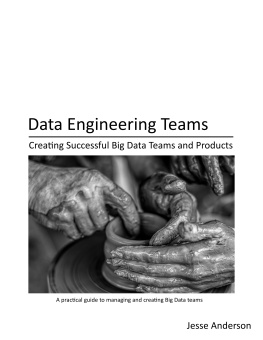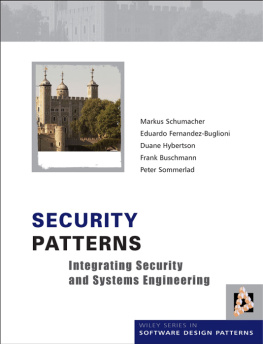Anderson - Security Engineering
Here you can read online Anderson - Security Engineering full text of the book (entire story) in english for free. Download pdf and epub, get meaning, cover and reviews about this ebook. year: 2010, publisher: Wiley, genre: Politics. Description of the work, (preface) as well as reviews are available. Best literature library LitArk.com created for fans of good reading and offers a wide selection of genres:
Romance novel
Science fiction
Adventure
Detective
Science
History
Home and family
Prose
Art
Politics
Computer
Non-fiction
Religion
Business
Children
Humor
Choose a favorite category and find really read worthwhile books. Enjoy immersion in the world of imagination, feel the emotions of the characters or learn something new for yourself, make an fascinating discovery.
Security Engineering: summary, description and annotation
We offer to read an annotation, description, summary or preface (depends on what the author of the book "Security Engineering" wrote himself). If you haven't found the necessary information about the book — write in the comments, we will try to find it.
Security Engineering — read online for free the complete book (whole text) full work
Below is the text of the book, divided by pages. System saving the place of the last page read, allows you to conveniently read the book "Security Engineering" online for free, without having to search again every time where you left off. Put a bookmark, and you can go to the page where you finished reading at any time.
Font size:
Interval:
Bookmark:
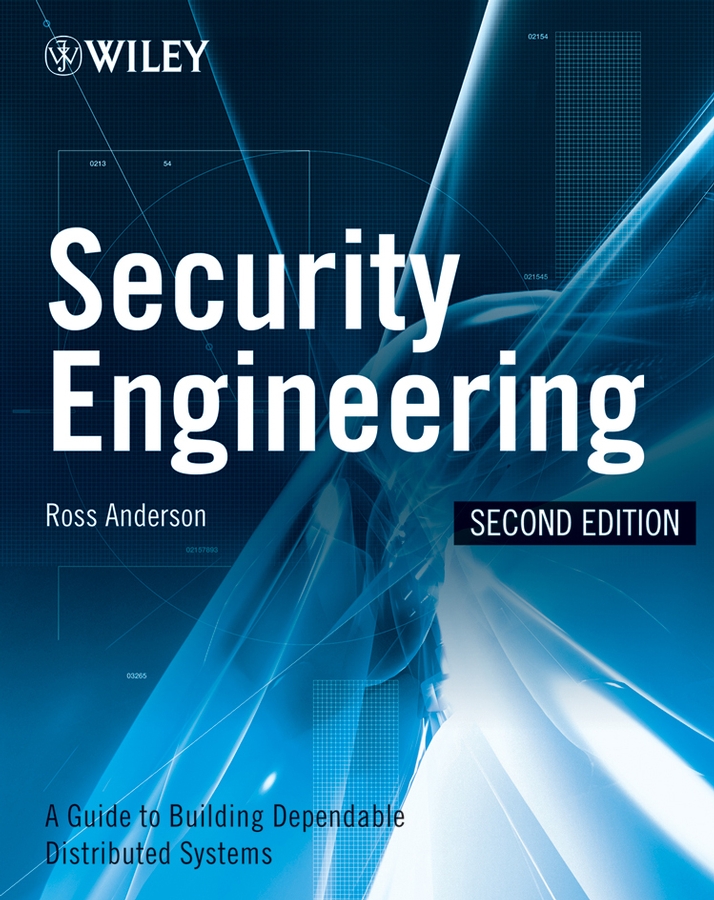
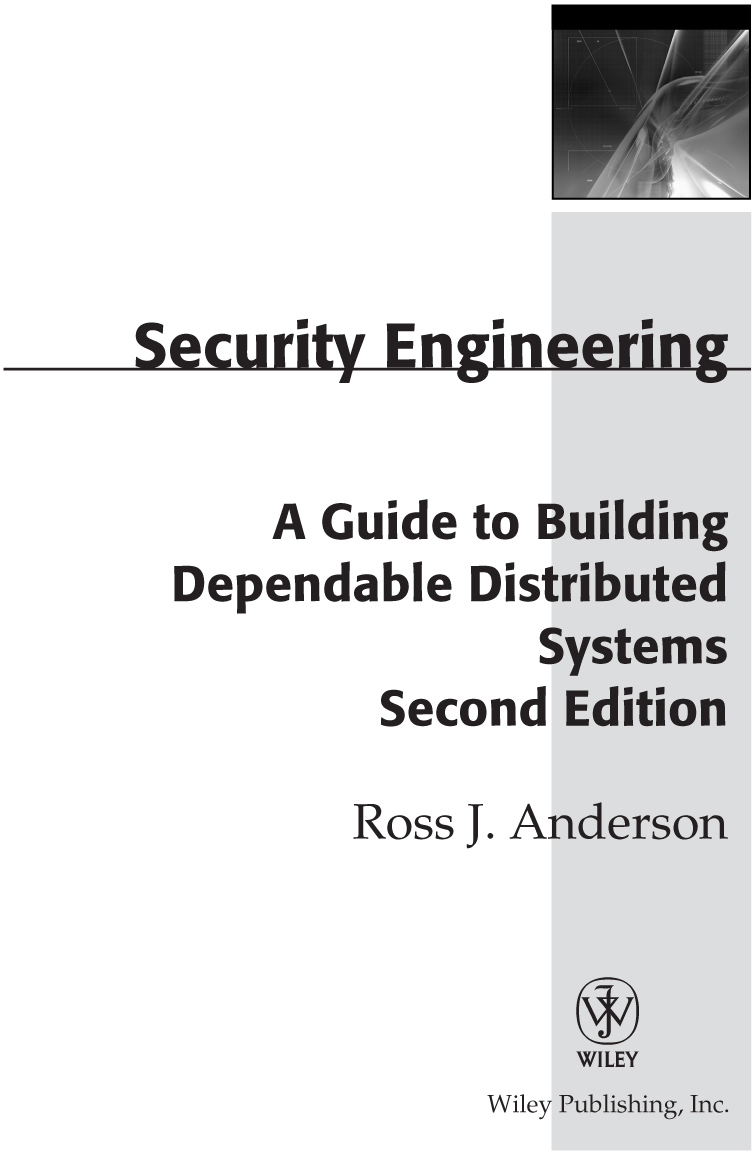
Security Engineering: A Guide to Building Dependable Distributed Systems,
Second Edition
Published by
Wiley Publishing, Inc.
10475 Crosspoint Boulevard
Indianapolis, IN 46256
Copyright 2008 by Ross J. Anderson. All Rights Reserved.
Published by Wiley Publishing, Inc., Indianapolis, Indiana
Published simultaneously in Canada
ISBN: 978-0-470-06852-6
No part of this publication may be reproduced, stored in a retrieval system or transmitted in any form or by any means, electronic, mechanical, photocopying, recording, scanning or otherwise, except as permitted under Sections 107 or 108 of the 1976 United States Copyright Act, without either the prior written permission of the Publisher, or authorization through payment of the appropriate per-copy fee to the Copyright Clearance Center, 222 Rosewood Drive, Danvers, MA 01923, (978) 750-8400, fax (978) 646-8600. Requests to the Publisher for permission should be addressed to the Legal Department, Wiley Publishing, Inc., 10475 Crosspoint Blvd., Indianapolis, IN 46256, (317) 572-3447, fax (317) 572-4355, or online at http://www.wiley.com/go/permissions.
Limit of Liability/Disclaimer of Warranty: The publisher and the author make no representations or warranties with respect to the accuracy or completeness of the contents of this work and specifically disclaim all warranties, including without limitation warranties of fitness for a particular purpose. No warranty may be created or extended by sales or promotional materials. The advice and strategies contained herein may not be suitable for every situation. This work is sold with the understanding that the publisher is not engaged in rendering legal, accounting, or other professional services. If professional assistance is required, the services of a competent professional person should be sought. Neither the publisher nor the author shall be liable for damages arising herefrom. The fact that an organization or Website is referred to in this work as a citation and/or a potential source of further information does not mean that the author or the publisher endorses the information the organization or Website may provide or recommendations it may make. Further, readers should be aware that Internet Websites listed in this work may have changed or disappeared between when this work was written and when it is read.
For general information on our other products and services or to obtain technical support, please contact our Customer Care Department within the U.S. at (800) 762-2974, outside the U.S. at (317) 572-3993 or fax (317) 572-4002.
Library of Congress Cataloging-in-Publication Data
Anderson, Ross, 1956
Security engineering : a guide to building dependable distributed systems / Ross J Anderson. 2nd ed.
p. cm.
Includes bibliographical references and index.
ISBN 978-0-470-06852-6 (cloth)
1. Computer security. 2. Electronic data processing-Distributed processing. I. Title.
QA76.9.A25A54 2008
005.1dc22
2008006392
Trademarks: Wiley, the Wiley logo, and related trade dress are trademarks or registered trademarks of John Wiley & Sons, Inc. and/or its affiliates, in the United States and other countries, and may not be used without written permission. All other trademarks are the property of their respective owners. Wiley Publishing, Inc. is not associated with any product or vendor mentioned in this book.
Wiley also publishes its books in a variety of electronic formats. Some content that appears in print may not be available in electronic books.
To Shireen
Credits
Executive Editor
Carol Long
Senior Development Editor
Tom Dinse
Production Editor
Tim Tate
Editorial Manager
Mary Beth Wakefield
Production Manager
Tim Tate
Vice President and Executive Group Publisher
Richard Swadley
Vice President and Executive Publisher
Joseph B. Wikert
Project Coordinator, Cover
Lynsey Stanford
Proofreader
Nancy Bell
Indexer
Jack Lewis
Cover Image
Digital Vision/Getty Images
Cover Design
Michael E. Trent
Preface to the Second Edition
The first edition of Security Engineering was published in May 2001. Since then the world has changed.
System security was one of Microsoft's lowest priorities then; it's now one of the highest. The volume of malware continues to increase along with the nuisance that it causes. Although a lot of effort has gone into defence we have seen Windows NT replaced by XP and then Vista, and occasional service packs replaced by monthly security patches the effort put into attacks has increased far more. People who write viruses no longer do so for fun, but for profit; the last few years have seen the emergence of a criminal economy that supports diverse specialists. Spammers, virus writers, phishermen, money launderers and spies trade busily with each other.
Cryptography has also moved on. The Advanced Encryption Standard is being embedded into more and more products, and we have some interesting developments on the public-key side of things too. But just as our algorithm problems get solved, so we face a host of implementation issues. Side channels, poorly designed APIs and protocol failures continue to break systems. Applied cryptography is harder than ever to do well.
Pervasive computing also opens up new challenges. As computers and communications become embedded invisibly everywhere, so problems that used to only afflict proper computers crop up in all sorts of other devices too. What does it mean for a thermometer to be secure, or an air-conditioner?
The great diversity of intelligent devices brings with it a great diversity of interests and actors. Security is not just about keeping the bad guys out, but increasingly concerned with tussles for power and control. DRM pits the content and platform industries against consumers, and against each other; accessory control is used to tie printers to their vendors cartridges, but leads to antitrust lawsuits and government intervention. Security also interacts with safety in applications from cars through utilities to electronic healthcare. The security engineer needs to understand not just crypto and operating systems, but economics and human factors as well.
And the ubiquity of digital devices means that computer security is no longer just a problem for a few systems specialists. Almost all white-collar crime (and much crime of the serious violent sort) now involves computers or mobile phones, so a detective needs to understand computer forensics just as she needs to know how to drive. More and more lawyers, accountants, managers and other people with no formal engineering training are going to have to understand system security in order to do their jobs well.
The rapid growth of online services, from Google and Facebook to massively multiplayer games, has also changed the world. Bugs in online applications can be fixed rapidly once they're noticed, but the applications get ever more complex and their side-effects harder to predict. We may have a reasonably good idea what it means for an operating system or even a banking service to be secure, but we can't make any such claims for online lifestyles that evolve all the time. We're entering a novel world of evolving socio-technical systems, and that raises profound questions about how the evolution is driven and who is in control.
The largest changes, however, may be those driven by the tragic events of September 2001 and by our reaction to them. These have altered perceptions and priorities in many ways, and changed the shape of the security industry. Terrorism is not just about risk, but about the perception of risk, and about the manipulation of perception. This adds psychology and politics to the mix. Security engineers also have a duty to contribute to the political debate. Where inappropriate reactions to terrorist crimes have led to major waste of resources and unforced policy errors, we have to keep on educating people to ask a few simple questions: what are we seeking to prevent, and will the proposed mechanisms actually work?
Font size:
Interval:
Bookmark:
Similar books «Security Engineering»
Look at similar books to Security Engineering. We have selected literature similar in name and meaning in the hope of providing readers with more options to find new, interesting, not yet read works.
Discussion, reviews of the book Security Engineering and just readers' own opinions. Leave your comments, write what you think about the work, its meaning or the main characters. Specify what exactly you liked and what you didn't like, and why you think so.

